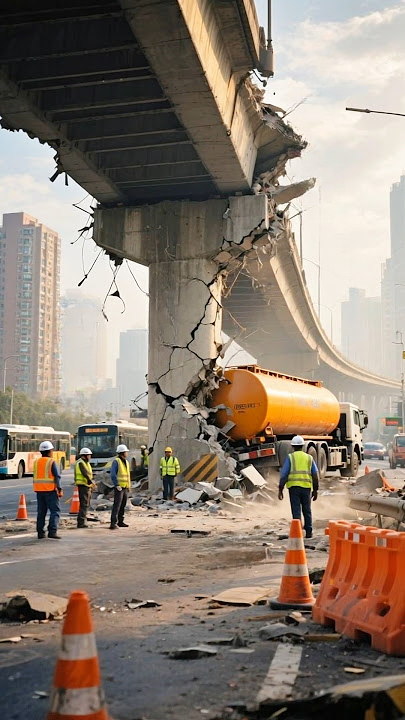
Was this a real-life tragedy caught on camera? A terrifying near-miss that went unreported? Or was it a staged performance designed to provoke fear and discussion?
The viral TikTok video, stripped of context and details, left those questions unanswered. And in that uncertainty, it found its power.
The Anatomy of a Viral Moment
The video—just seconds long—spreads tension instantly. It opens with the tanker positioned directly under a crumbling bridge frame. Viewers notice fractured slabs of concrete overhead, jagged edges that seem moments from falling. The supporting beams look worn, as if strained beyond their limit.
The sense of danger is unavoidable. Even without sound, the clip seems to carry an audible warning: one shift, one tremor, and the bridge could collapse.
But what the video doesn’t show is just as important. Was there movement after the clip ended? Did the tanker escape unharmed? Was the bridge intentionally staged for demolition or repair?
Without that information, the footage becomes more than documentation—it transforms into an open-ended mystery that audiences can project their own fears and interpretations onto.
Millions Captivated
On TikTok and other platforms, the video exploded. Within days, it had been reposted thousands of times, gathering comments from people across continents.
Social media users nicknamed it “Seconds from Collapse.” Some speculated it was an authentic recording of a structural failure. Others suggested it was staged for awareness or even edited for dramatic effect.
The uncertainty only fueled its reach. People shared it not just to gasp at the danger, but also to debate its authenticity. The more theories circulated, the more the clip’s power grew.
Why This Clip Resonates
At its core, the video tapped into a primal fear—the sudden failure of structures we depend on every day. Bridges are meant to symbolize stability and connection. When they appear fragile, the illusion of safety cracks alongside the concrete.
Viewers around the world couldn’t look away because, consciously or not, many have driven across bridges, walked beneath overpasses, or waited in traffic under concrete spans. The video forced them to imagine: What if it happened here? What if it happened to me?
This universal recognition is what turned a few seconds of footage into a viral storm.
Real-Life Echoes
Although the origins of the clip remain unclear, its imagery echoes real-world disasters that have unfolded in recent decades. For many viewers, it brought back haunting memories of bridges that did not hold.
- Taiwan (2019): The sudden collapse of the Nanfang’ao Bridge shocked the world. A tanker and several fishing boats were caught in the disaster, and videos of the collapse spread across news outlets and social media.
- India (2025): The Gambhira Bridge in Gujarat gave way during morning traffic, leaving vehicles, including a tanker, stranded. Rescue teams worked tirelessly in high-risk conditions for weeks.
- Brazil (2024): A major highway bridge failed as a tanker carrying industrial chemicals attempted to cross. The aftermath included both human casualties and environmental harm.
When audiences saw the viral tanker video, these real tragedies formed the backdrop. Whether the clip was staged or genuine, it resonated because it mirrored events that had already changed lives in devastating ways.
Infrastructure in Question
The video also reignited an important public discussion: the state of infrastructure. Around the globe, bridges, highways, and tunnels are aging faster than they are being repaired.
In the United States, reports by the American Society of Civil Engineers have consistently identified thousands of bridges as structurally deficient or functionally obsolete. In Europe and Asia, similar assessments reveal the same concerns.
Everyday traffic—including heavy vehicles like fuel tankers—adds stress to structures that were often built decades ago, for populations and traffic volumes far smaller than today’s demands.
in stark imagery what reports and statistics often fail to convey: the fragile balance between safety and collapse.
The Role of Social Media
Part of what made the “Seconds from Collapse” video so powerful was its format. Short, looping clips thrive on TikTok because they demand immediate attention. Unlike long news reports, a few seconds of suspense can spark millions of shares.
But there is a double edge. Social media can blur the line between fact and fiction. Was this video authentic or staged? Was it an accident or an awareness campaign? Those questions may never be answered.
What is undeniable, however, is the video’s impact. It pushed millions of people to think about infrastructure safety, perhaps more than a government report or policy announcement ever could.
Fear, Fascination, and Human Psychology
Psychologists suggest that viral clips like this resonate because they allow people to confront fear in a safe way. Watching a bridge tremble on screen creates adrenaline, but viewers remain physically secure in their homes or offices.
The uncertainty of whether the clip is real only heightens the fascination. Humans are drawn to mysteries, and when safety is involved, curiosity deepens. This blend of fear and intrigue is a formula that keeps people sharing and discussing content far beyond its original posting.
Stories of Resilience
Behind the drama, it’s worth remembering the real-world heroes who respond when such collapses occur. Emergency responders, engineers, and ordinary citizens often risk their lives to save others during infrastructure failures.
From the divers who searched the waters beneath Taiwan’s collapsed bridge, to the engineers in India who stabilized dangerous wreckage, to the firefighters in Brazil who contained hazardous spills, these individuals turn moments of chaos into stories of resilience.
The viral video, while dramatized, unintentionally reminded audiences of the importance of preparedness and courage in the face of sudden disaster.
Lessons Moving Forward
Whether the tanker clip was authentic, staged, or something in between, it delivers lessons worth considering:
- Infrastructure needs investment. Neglecting maintenance can transform small cracks into catastrophic failures.
- Transparency matters. Clear communication from authorities about risks helps prevent panic and misinformation.
- Preparedness saves lives. Emergency drills, trained response teams, and quick-thinking citizens often make the difference between tragedy and survival.
- Media shapes perception. A short video can ignite a global debate, proving the importance of responsible sharing and fact-checking.
Final Reflection
The viral image of a tanker frozen beneath a damaged bridge was more than fleeting entertainment. It was a stark reminder of human vulnerability, the fragility of infrastructure, and the unpredictability of life.
Whether the footage captured an authentic near-miss, a dramatized scenario, or controlled demolition, its influence was undeniable. It sparked conversations about safety, trust, and the systems we rely on without thinking twice.
In a world where one overlooked crack can change everything, the message is clear: vigilance is not optional. Maintenance is not a luxury. Preparedness is not an afterthought.
What began as a mysterious TikTok clip has become a global metaphor. It reminds us that stability is never guaranteed—and that awareness, responsibility, and resilience are the strongest supports we can build.



